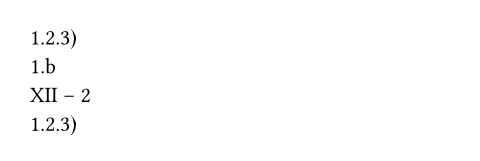このページは日本語に翻訳済みです。
numbering
順序に応じた番号付け。
番号付けは、一連の数値をコンテンツとしてどのように表示するかを定義します。 これはパターン文字列または任意の関数によって指定されます。
番号付けパターンは、数値を置き換えるためのカウント記号、それらに付けるプレフィックス、そして1つのサフィックスから構成されます。 プレフィックスとサフィックスは、そのままの形で繰り返し使用されます。
例
#numbering("1.1)", 1, 2, 3) \
#numbering("1.a.i", 1, 2) \
#numbering("I – 1", 12, 2) \
#numbering(
(..nums) => nums
.pos()
.map(str)
.join(".") + ")",
1, 2, 3,
)

番号付けのパターン指定と関数指定
Typstではパターン指定または関数指定で番号付けを定義できる場面がいくつかあります。
例えば、見出しや図表などに番号を付ける際に使用します。
いずれの場合も、指定の形式は後述するnumberingパラメーターと同じです。
次の例は、番号付け用の関数が、単に数値を受け取ってcontentを返す通常のfunctionであることを示しています。
#let unary(.., last) = "|" * last
#set heading(numbering: unary)
= First heading
= Second heading
= Third heading

引数引数引数は関数への入力値です。関数名の後に括弧で囲んで指定します。
numbering(,)->any番号付けの表示形式を定義します。
カウント記号 として使用できるパターン文字は 1, a, A, i, I, α, Α, 一, 壹, あ, い, ア, イ, א, 가, ㄱ, *, ١, ۱, १, ১, ক, ①, ⓵があります。
これらの文字は、大文字・小文字を維持したまま、対応する順序の番号文字に置き換えられます。
記号*は *, †, ‡, §, ¶, ‖の順序で番号付けすることを意味します。
項目が6つ以上ある場合は、記号を繰り返し使用して番号を表現します。
サフィックス とは、最後のカウント記号の後ろに置く文字列です。 これらは、生成された番号文字の末尾に、そのままの形で繰り返し表示されます。
プレフィックス は、カウント記号でもサフィックスでもない文字列です。 それぞれのカウント記号の前に、そのままの形で繰り返し表示されます。
このパラメータには、数値を個別の引数として受け取る任意の関数も指定できます。
関数が与えられた場合、numbering関数はその引数をそのまま関数に渡します。
これ自体は特に便利というわけではありませんが、番号付けがパターン指定であっても関数指定であっても、番号付けの定義をnumbering関数に適用できるという意味を持ちます。
numbers必須引数必須引数必須引数は、関数を呼び出す際に必ず指定しなければなりません。位置引数位置引数位置引数は順序通りに指定することで、引数名を省略して設定できます。可変長引数可変長引数可変長引数は複数回指定することができます。
numbers番号付けを適用する対象の数値。正の数で与えてください。
番号付けがパターン指定であり、カウント記号よりも多くの数値が指定された場合、最後のカウント記号とそのプレフィックスが繰り返されます。